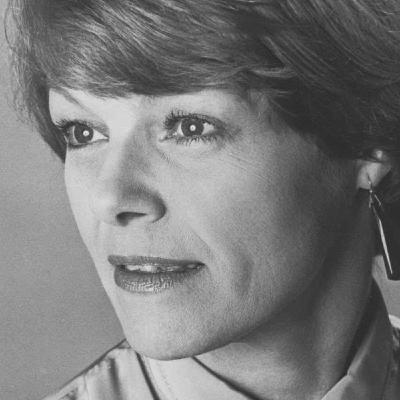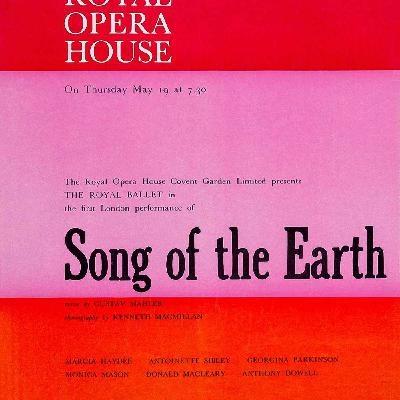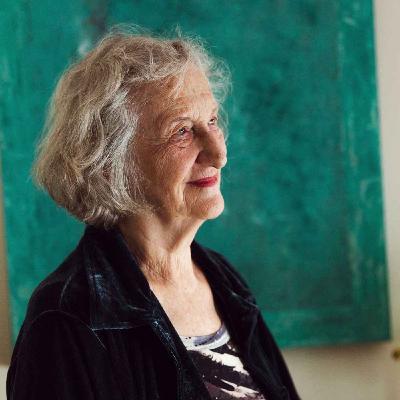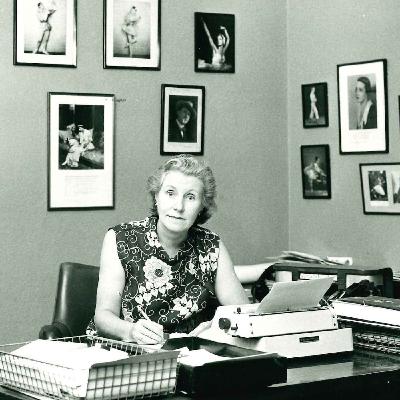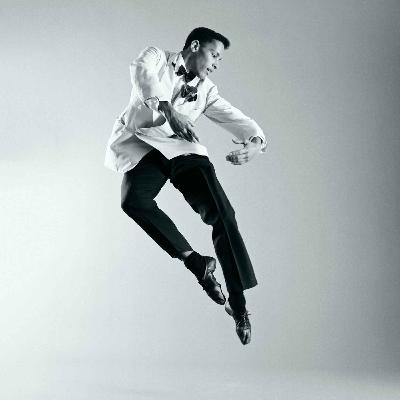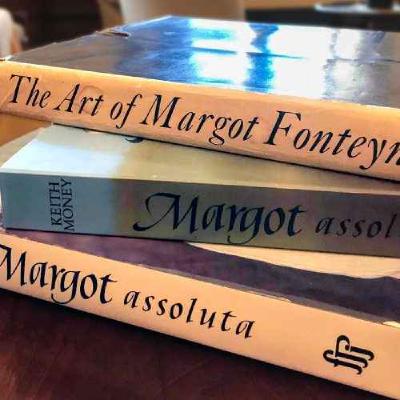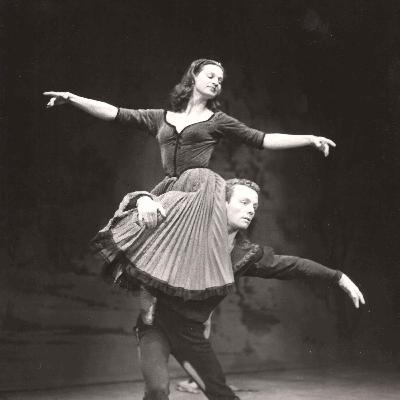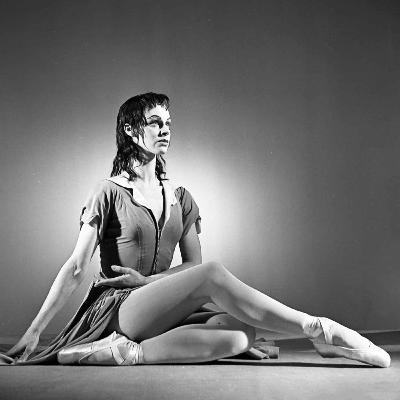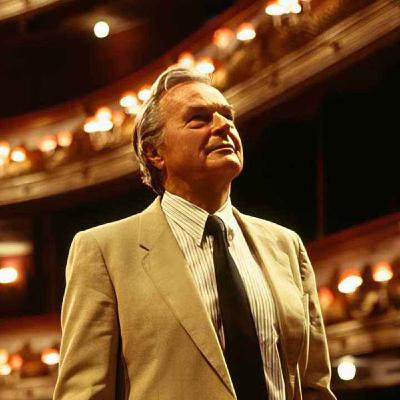Discover Voices of British Ballet
Voices of British Ballet

Voices of British Ballet
Author: Voices of British Ballet
Subscribed: 17Played: 151Subscribe
Share
© Voices of British Ballet
Description
Voices of British Ballet tells the story of dance in Britain through conversations with the people that built its history. Choreographers, dancers, designers, producers and composers describe their part in the development of the artform from the beginning of the twentieth century.
Hosted on Acast. See acast.com/privacy for more information.
43 Episodes
Reverse
Romayne Grigorova has had a long, distinguished career in ballet and the theatre. Here, in conversation with Patricia Linton, founder and director of Voices of British Ballet, she focuses on her early years, much of which was coloured by World War Two. In 1943, after training at the Sadler’s Wells Ballet School, she worked with the Sadler’s Wells Opera on The Bartered Bride in London during the Blitz and on tour. In 1945 she travelled to Germany with the opera under the auspices of ENSA. She then joined Ballet Rambert, and went to Germany again, to Berlin, where she delivered food parcels to a German singer and her family in the Russian zone, and scissors to Lotte Reiniger, a famous German film director and pioneer of silhouette animation. Romayne Grigorova also speaks of her dealings with Marie Rambert and Andrée Howard, joining Sadler’s Wells Theatre Ballet in 1951 and touring to North America.The interview was recorded in 2003, and is introduced by Monica Mason who spoke to Natalie Steed before Romayne's death in July 2025.Romayne Grigorova was born in Sandwich, Kent, in 1927. She studied under Vera Volkova, Ninette de Valois, George Goncharov and Ailne Philips. Her first appearance on the professional stage was in 1942. In 1943, after training at the Sadler’s Wells Ballet School for a further year, she danced in ballets with the Sadler’s Wells Opera in this country and, in 1945, on tour in Germany under ENSA. She joined Ballet Rambert in 1946 and then danced with the Anglo-Polish and Metropolitan Ballets until 1947, when the latter folded.Grigorova then worked in the commercial theatre until 1951, including performing in three pantomimes, before joining Sadler’s Wells Theatre Ballet, where she remained until 1955. She was ballet mistress for the stage musical Can-Can in 1955, and for the St Gallen Ballet in 1956. In 1957 she became ballet mistress for the Opera Ballet at the Royal Opera House, for whom she choreographed many ballets. She retired from this post in 1992 but continued to teach on a freelance basis. She performed small character roles with The Royal Ballet at Covent Garden, many of which had been created for her, such as Lady Montague in Kenneth MacMillan’s Romeo and Juliet and The Housekeeper in Peter Wright’s The Nutcracker. Romayne Grigorova was appointed an MBE for her services to dance in 2017. She died in July 2025.Photo by Donald Southern courtesy of The Royal Ballet Hosted on Acast. See acast.com/privacy for more information.
When Cassa Pancho decided to interview Black female ballet dancers in the UK for her degree dissertation in 1999, she could not find any. So she seized the moment, setting out on the path that was to lead, in 2001, to the company known as Ballet Black and its associated schools. Here, the indomitable Cassa talks to Patricia Linton, founder and director of Voices of British Ballet, about the early days of her career, her expectations for the company and the schools, the misunderstandings she has had to overcome and, above all, her insistence that at all levels the now highly acclaimed Ballet Black is a balletic enterprise, with all that entails in terms of standards. The interview, was recorded in 2010 and is introduced by Kenneth Olumuyiwa Tharp.Cassa Pancho was born in London in 1978, to Trinidadian and British parents. Her original ambition was to become a ballerina. She trained at the Royal Academy of Dance and in 1999 gained her degree from Durham University.In 2001, at the age of 21, she founded Ballet Black in order to promote diversity in ballet and to increase the number of Black and Asian dancers in mainstream ballet companies.She has built a distinct and unique repertoire for her company from a wide range of distinguished choreographers. Ballet Black tours extensively, both in the UK and abroad, with regular London seasons at venues such as the Barbican Theatre and the Linbury Theatre of the Royal Ballet and Opera. Cassa realised from the start the importance of building for the future, and in 2002 set up the Ballet Black Junior School in Shepherd’s Bush, as well as an associate programme for younger pupils. She oversees the programme for young dancers, and teaches regularly herself.In 2009 Cassa Pancho graduated from the National Theatre Leadership programme. Also in 2009 Ballet Black won the Critics’ Circle National Dance Award for Outstanding Company, and the award for the Best Independent Company in 2012. She was appointed an MBE in 2013 for services to the Arts and was given the Freedom of the City of London in 2018. She is a Patron of Central School of Ballet and a Vice President of the London Ballet Circle.Photo: Ballet Black rehearsals Cassa Pancho [Artistic Director]; at the Fonteyn Studio, Royal Opera House, London, UK; 19 November 2006; Credit: Bill Cooper / ArenaPAL Hosted on Acast. See acast.com/privacy for more information.
Stephen Johnson and Patricia Linton spoke to Yvonne Minton in 2017 about her role as a young member of The Royal Opera, singing Mahler’s Das Lied von der Erde for The Royal Ballet in 1966. Her memories about that, and about the questions which were raised at the time, were crystal clear. She also has some wonderful reminiscences of life in the Royal Opera House at the time, including a bird’s-eye view of the great Maestro Georg Solti. At the end there is a gentle reminder that change is not always easy – in any profession. The interview is introduced by Stephen Johnson.The singer Yvonne Minton was born in Sydney, Australia in 1938. Having studied and performed in Australia, she came to London in 1961 to pursue her studies and career. By 1966, having become a regular member of the company of the Royal Opera House at Covent Garden, she sang in Gustav Mahler’s Song of the Earth for The Royal Ballet. She created the role of Thea in Michael Tippett’s opera The Knot Garden in 1970. She appeared in a variety of roles in most of the major opera houses in Europe, including Bayreuth, Salzburg and Paris, and at the Metropolitan Opera in New York. She made concert appearances with many of the best orchestras in the world and was particularly noted for her work with Georg Solti, with whom she made many recordings. In 1980, after a decade or more of prestigious international work, she was appointed CBE for services to music. Hosted on Acast. See acast.com/privacy for more information.
In 1969, Peter Darrell choreographed Beauty and the Beast for Scottish Theatre Ballet. Here Thea Musgrave discusses with Stephen Johnson the challenges and idiosyncrasies she found when creating the music. She was amused to discover that she wasn’t the first composer to have to succumb to balletic demands! Deep, observant and fiercely straightforward, it is fascinating to hear Musgrave describe so poetically another work she created for dance, Orfeo. The interview is introduced by Stephen Johnson.Thea Musgrave is one of the United Kingdom’s most important and prolific contemporary composers, pursuing her own idiom and musical sensibility throughout a long and distinguished career. She was born in Barnton, in Edinburgh, and went to school in Shropshire. After study at the University of Edinburgh, from 1950 until 1954 she studied in Paris, working under the direction of the redoubtable and influential Nadia Boulanger. She attended the Tanglewood Festival (in Massachusetts) in 1958, studying under Aaron Copeland.In the late 1950s and 1960s she established herself in London as a notable figure in British musical life. In 1970 she was a guest professor at the University of California (Santa Barbara). In 1972 she married the American musician Peter Mark and has lived in the United States of America ever since, where she has held many notable positions, including a distinguished professorship at City University, New York, from 1987 until 2002.Musgrave’s style has been described as a synthesis of expression and abstraction, noted for its drama and complexity, often with a strong romantic undercurrent. Her many works include several operas, including ones devoted to Mary Queen of Scots, the abolitionist and social activist Harriet Tubman and the statesman Simón Bolívar, as well as many concerti and orchestral works, often inspired by poetic and pictorial themes. As well as working in America, she has made frequent visits to the United Kingdom and Europe, including taking part in the BBC’s ‘total immersion’ weekend devoted to her works in London in 2014. She composed the scores for two ballets, Beauty and the Beast in 1969 and Orfeo in 1975. Thea Musgrave has received many honours, including two Guggenheim Fellowships and many honorary degrees. She was awarded a CBE for services to music in 2002. Hosted on Acast. See acast.com/privacy for more information.
This ‘voice’ of British Ballet is that of Pamela May. She was born in 1917 and after retiring as a ballerina with The Royal Ballet became the teacher par excellence for generations of Royal Ballet School dancers. May, interviewed by Patricia Linton, starts this clip by describing being a student herself in 1932 and watching Adeline Genée, the great Danish ballerina, and also the first President of the Royal Academy of Dance, perform a minuet with Anton Dolin on tour in Copenhagen. The interview is introduced by the writer and critic Alastair Macaulay who gives a wonderful context and explains how Ninette de Valois became known as "Madam."Pamela (Doris) May was born in San Fernando, Trinidad in 1917, where her father was an oil engineer. The family returned to England in 1921. She first studied ballet with Freda Grant, and later in Paris with Olga Preobrajenska, Lubov Egorova and Mathilde Kschessinska. She joined the Vic-Wells Ballet School in 1933 and made her debut with the Vic-Wells Ballet in the pas de trois from Swan Lake in 1934.May became a principal with company and danced the whole gamut of the repertoire, including creating many roles, until she retired from dancing ballerina roles in 1952. She then became a leading mime and character artist and stayed with what became known as The Royal Ballet in this capacity until 1982. All this happened alongside her teaching at The Royal Ballet School from 1954 until 1977. Pamela May was appointed OBE for services to dance in 1977. She died in 2005. Hosted on Acast. See acast.com/privacy for more information.
A conversation Mary Clarke, former editor of Dancing Times. It is thanks to her godson, Jerome Monahan, that we have this evocative and informative interview with Mary Clarke. Writer extraordinaire on all aspects of ballet, she hated the sound of her own voice and even more the look of her transcript. In these few minutes, however, she manages to convey the feeling of several eras, and of many people and happenings. She also explains, in her low-key erudite way, how the word ‘balletomane’ entered the English language. Mary is interviewed by her friend, the former Royal Ballet soloist Meryl Chappell, and the interview is introduced by Jonathan Gray, former editor of Dancing Times, who worked closely with Mary during her later years.Mary Clarke was the dance historian and writer par excellence. Her two books on the birth of British ballet in the 20th Century - The Sadler’s Wells Ballet: A History and Appreciation (London, 1955) and Dancers of Mercury: The Story of Ballet Rambert (London, 1962) - remain the starting point for all future historians of ballet in the UK.Mary Clarke was born in London in 1923. After her schooling at Mary Datchelor School, she worked as a typist at Reuter’s Press Agency. She was a youthful enthusiast for ballet and all things theatrical, and her career as a ballet critic and journalist began in 1943 with her first published article (prophetically for Dancing Times) and with her appointment in the same year as London correspondent for the American Dance Magazine. After the end of the war Clarke wrote for the London-based Ballet Today magazine. From the mid-1950s until 1970 she was also the London correspondent for Dance News, another American publication, which was then run by the distinguished critic and writer Anatole Chujoy. In 1954 Clarke became the assistant editor of Dancing Times, first under Philip Richardson and then for Arthur Franks. On Franks’ sudden death in 1963, Clarke became editor of Dancing Times, a post she held until her retirement in 2010. For over half a century she chronicled the changing trends in ballet and dance worldwide and their effects with impeccable judgement and an encyclopaedic knowledge.Clarke was dance critic for The Guardian newspaper from 1977 to 1994 and associate editor (with Arnold L Haskell) for many years of the Ballet Annual. She co-authored a range of books with the ballet critic and writer, Clement Crisp, notably Ballet: An Illustrated History (London, 1973) and The Encyclopaedia of Dance and Ballet (London, 1977) with David Vaughan. Her quiet demeanour and straightforward style belied deep thought and high ambition for the art. Her contributions to A Dictionary of Modern Ballet (London, 1959) are awe-inspiring in their clarity and humanity, qualities rare in a critic. She was awarded the Queen Elizabeth II Coronation Award of the Royal Academy of Dance in 1990, Poland’s Nijinsky Medal in 1996, and she was made a Knight of the Order of Dannebrog in 1992. Mary Clarke died in 2015. Hosted on Acast. See acast.com/privacy for more information.
In this podcast, the dancer and teacher Leo Kersley discusses his formative years in London in the 1930s and the many different companies he eventually worked with during the Second World War, including a stint at the Windmill Theatre. Talking to Patricia Linton, director of Voices of British Ballet, he also mentions how, as a conscientious objector, he was briefly imprisoned at the start of the war. The interview is introduced by Jane Pritchard.Leo Kersley was born in poverty in Hertfordshire in 1920. His family having moved to London, he studied dance under a number of teachers, including Marie Rambert at the Mercury Theatre in 1934, dancing professionally from time to time. He was a soloist in Ballet Rambert from 1936 to 1939, and in 1939 worked for the Ballet Trois Arts.On the outbreak of World War Two in 1939, he registered as a conscientious objector and was briefly imprisoned. On his release, during 1940 and 1941 he combined his work in a hospital with dancing for Rambert in the evenings alongside his first wife, Celia Franca. He was a member of Sadler’s Wells Ballet from 1941-1942, and then the International Ballet. He was a member of the Anglo-Polish Ballet from 1942-1943. From 1945 until 1951 Kersley performed with Sadler’s Wells Theatre Ballet. In 1952, Kersley went to teach in Denver, Colorado, and in 1953 to Rotterdam in The Netherlands. Whilst there he danced with a number of companies but returned to England in 1959 to set up his own school in Harlow, which he ran until his second wife, Janet Sinclair. With Sinclair, who died in 1999, he published the well-regarded Dictionary of Ballet Terms in 1952. PhotoAnne Heaton (as A Serving maid), Leo Kersley (as A Shepherd) in THE GODS GO A'BEGGING; Sadler's Wells Opera Ballet; at Sadler's Wells Theatre, London UK 1946;Credit : Frank Sharman / Royal Opera House / ArenaPAL.com Hosted on Acast. See acast.com/privacy for more information.
You can hear in her voice how much Lucette Aldous appreciated and revelled in every step of her way from Ballet Rambert to Festival Ballet and The Royal Ballet. There’s a fascinating glimpse of the young Kenneth MacMillan and later the mindfulness of the much older John Field. In conversation with Patricia Linton, Lucette speaks about joining – and then leaving – Ballet Rambert; about working in Festival Ballet with John Gilpin and being taken under Anton Dolin’s wing, especially for Giselle; about how, when she went to The Royal Ballet, Field ‘wrapped his ballerinas in cotton wool’; and about how MacMillan’s earlier approach to choreography differed in his later ballets. The interview is introduced by Deborah Weiss.Lucette Aldous was born in New Zealand in 1939, but lived in Sydney, Australia, from the age of three months. After studying in Sydney, she won a scholarship to study at The Royal Ballet School in 1955. She joined Ballet Rambert in 1957, being promoted to ballerina in 1958. She went to Festival Ballet in 1963, dancing with John Gilpin, and then in 1967, at the behest of John Field, to The Royal Ballet.Aldous returned to Australia in 1970 and joined The Australian Ballet. When there she was invited to work with the Kirov Ballet, one of the first Australian dancers to be so honoured. Acclaimed in many ballerina roles of all parts of the repertoire, her partnerships with Rudolf Nureyev in The Nutcracker for The Royal Ballet and in Don Quixote for The Australian Ballet were noteworthy. She retired from dancing in 1976, subsequently teaching in Perth, Western Australia. In 2018 Lucette Aldous was made a Companion of the Order of Australia. She died in 2021. Hosted on Acast. See acast.com/privacy for more information.
In conversation with Alastair Macaulay in 2019, Kenneth Tharp conveys a multitude of observations, along with historical content, and both personal and professional insights. He paints a picture of a vibrant moment in the unfolding of dance history in this country and all the key people of this moment are there. The interview is introduced by Alastair Macaulay.Kenneth Olumuyiwa Tharp, a key figure in UK arts and culture, was born in Croydon in 1960, with a Nigerian father and an English mother. He attended the Perse School, Cambridge, and the Cambridge College of Arts and Technology, before training at the London Contemporary Dance School, graduating in 1981. When the LCDS began offering degrees he returned to study whilst a member of the London Contemporary Dance Theatre and gained a first-class degree in 1987.He performed professionally as a dancer for 25 years, first with the London Contemporary Dance Theatre (from 1981 until 1994) and then with Arc Dance Company (from 1994 to 2005). He was co-director of Artyfartyarts, a multidisciplinary arts group, and he has choreographed over 45 dances. He was chief executive of The Place from 2007 until 2016, and director of The Africa Centre, London from 2018 to 2020. He has worked with The Royal Ballet School’s Dance Partnership and Access Programme as a choreographer, teacher, director and advisor, and taught for many years at The Royal Ballet School’s Summer School at White Lodge. Among many other roles in the arts, he has served on the board of the Royal Opera House, and as a trustee of Matthew Bourne’s New Adventures Company and the Chineke! Foundation and Orchestra. Kenneth Olumuyima Tharp was appointed an OBE in 2003 and a CBE in 2017, both for services to dance. Hosted on Acast. See acast.com/privacy for more information.
Keith Money is a pioneering photographer of ballet. He moved from loving and photographing horses to loving and photographing dancers. He decided he wanted to see the nuts and bolts of a dancer’s life, so he developed an entirely different approach to ballet photography. In this podcast he explains to Patricia Linton how it was watching Margot Fonteyn and her artistry that first inspired him to work with dancers. The interview is introduced by Tobias Round who is the son of dance photographer, Roy Round.Keith Money was born in New Zealand in 1927 and educated there. He received a Fine Art degree from the Elem School of Fine Art before setting off for the country of his English forbears. Gifted in four disciplines, writing, photography, and painting in oil and watercolour, he has written, painted and travelled extensively.Initially a contributor and illustrator for a variety of equestrian publications, Money also wrote for national newspapers and journals. He then authored books of his own and published collections of his own extraordinary photographs, as well as painting in oils and watercolour. Throughout the 1960s, 1970s and 1980s he had both solo exhibitions and was included in many others. His work has given lasting pleasure. The nub of it all is his wonderful eye, whatever his subject, whether it is horses, dancers or skies; and it is this that will hold true for posterity. Hosted on Acast. See acast.com/privacy for more information.
Joseph Horowitz is the composer of16 ballets scores, two one-act operas, five string quartets, nine concertos, and many works for wind and brass, as well as music for television. He made his Royal Ballet debut in 1990, revising Adolphe Adam’s score for Peter Wright’s production of Giselle. Other ballets include Alice in Wonderland, composed for Festival Ballet in 1953. In this episode he explains to Patricia Linton that his early enthusiasm was for the visual arts, and that it was only from about the age of 19 that he turned seriously to music. After a degree at Oxford University, he attended the Royal College of Music and then went to Paris for revelatory study with the legendary Nadia Boulanger. While there he went to Boris Kochno’s ballet class, saw Yvette Chauviré dance (which greatly inspired him), and was given sage advice on writing for the ballet by Roland Petit. After that, in 1951 he conducted for Colonel de Basil’s Ballet Russe, at the end of their existence. Colin Davis, a contemporary as a student, was co-conductor, and the ballet master was Serge Grigoriev, whose musical understanding turned out to be somewhat idiosyncratic. The episode is introduced by Stephen Johnson.Joseph Horowitz, the British composer and conductor, was born to a Jewish family in Vienna in 1926. His father was the co-founder of Phaidon Press, which he founded in 1923. In 1938, the family emigrated from Austria, to escape the Nazi threat, and to seek a safer life in England. Horovitz read music and modern languages at New College, in Oxford, while simultaneously giving piano recitals for army camps during the war. This progressed to studying composition at the Royal College of Music in London under Gordon Jacob, where he won the Farrar prize. He then went to Paris to continue his studies under Nadia Boulanger.In 1950, Horovitz became the music director of the Bristol Old Vic. During the Festival of Britain in 1951 he conducted ballet and concerts at the Festival Amphitheatre in London. He then conducted for Colonel de Basil’s Ballet Russe. During the 1950s, a number of his compositions were broadcast on the BBC, and in 1961 he became Professor of Composition at the Royal College of Music where he was later awarded an Honorary Doctor of Music.As well as the Commonwealth Medal in 1959, Jospeh Horowitz won many awards for his music, both in this country and abroad. He died in 2022.Image: © Wolfgang Jud Hosted on Acast. See acast.com/privacy for more information.
In this podcast featuring Donald MacLeary, the ballerina Darcey Bussell makes a fascinating and full introduction to her friend and mentor. She stresses the importance of a coach who is both knowledgeable and intuitive, for a dancer flourish. The backbone of British ballet is storytelling and both Darcey and Donald underline how important it is to keep this tradition alive. Donald Macleary is in conversation with the dance critic Alastair Macaulay.Donald MacLeary was a dancer noted for his finesse and natural romanticism, and for his legendary partnering skills. He had an association with The Royal Ballet for 48 years. Born in Glasgow in 1937, he studied ballet with Sheila Ross from 1950. He then went to the Sadler’s Wells Ballet School and joined Sadler’s Wells Theatre Ballet in 1954. In 1959, when Svetlana Beriosova asked for him as her regular partner, he moved to The Royal Ballet at Covent Garden, becoming its youngest principal dancer at the time.MacLeary created roles for John Cranko, including in Brandenburg 4 and 6 in 1964, and for Kenneth MacMillan, including in The Burrow (1958), Symphony (1963) and Elite Syncopations (1974). After his retirement from dancing in 1975 he was appointed ballet master for The Royal Ballet from 1976 until 1979. He later appeared as a guest artist for a number of companies, including Scottish Ballet, and was a répétiteur at The Royal Ballet from 1981 (for principal dancers from 1984) until his retirement in 2002. Donald MacLeary was appointed an OBE for services to dance in 2004. Hosted on Acast. See acast.com/privacy for more information.
Here Barbara Fewster tells us about working at The Royal Ballet School. Her voice has a mixture of authority and kindness which will be remembered by literally thousands of students over the 40-odd years she both taught and directed there. However, there is also has a tinge of something students rarely noticed, something more searching and pensive, of sadness even. Many dancers, both in The Royal Ballet and in many other companies, owe their careers to her, and remember what she did for them with genuine gratitude. Patricia Linton, founder and director of Voices of British Ballet, feels she owes her own career to Fewster, saying, “She scooped me up from a moment of student gloom when I was about 18 and gave me an opportunity that led to a chance to join The Royal Ballet’. In this interview Barbara Fewster talks to Patricia Linton who also introduces the episode in conversation with Natalie Steed.Barbara Fewster was born in 1928. She studied dancing at the Wessex School in Bournemouth before joining the Sadler’s Wells Ballet School in 1942. By 1943, at the height of World War Two, she was performing and touring the country with the Sadler’s Wells Opera Ballet. In 1946 she became a founder member of the Sadler’s Wells Theatre Ballet, a company that became a hot bed of talent for the future of British ballet and a springboard for many and varied careers. There were extensive tours, both at home and abroad, where Fewster was at first a dancer, and then assistant ballet mistress from 1947. When Peggy Van Praagh left the company in 1951, Fewster became the ballet mistress.Against all the odds of a depressed post-war Britain, ballet was vibrant. The emergence of a swathe of talented choreographers, together with a remarkably varied existing repertoire, helped to build a bright future. On leaving the Sadler’s Wells Theatre Ballet in 1954, Fewster toured the United States of America as ballet mistress with the Old Vic Company’s production of A Midsummer Night’s Dream, before joining the staff of the Sadler’s Wells Ballet School, which was now based with the Sadler’s Wells Ballet at Barons Court in West London. She became deputy principal to Ursula Moreton in 1967 and succeeding her as principal in 1968. Fewster joined the Grand Council of both the Imperial Society of Teachers of Dancing (ISTD) and the Royal Academy of Dance (RAD). She was made an Honorary Fellow of the Cecchetti Society by its founder, Cyril Beaumont, in the late 1960s.Barbara Fewster was an indefatigable traveller and was always inspired by her experiences of teaching and adjudicating worldwide. She was at the heart of an historic cultural exchange with China in the early 1980s, involving an exchange of students and teachers. Fewster was also the driving force of a video for the Cecchetti Society in 1988, to promote and improve good practice in the teaching and understanding of pointework. She has frequently mounted ballets for professional companies, notably Coppélia for the Turkish Ballet in 1993 and a revival of La Fête étrange by Andrée Howard, a ballet close to her heart, for The Royal Ballet in 2003. There is a scholarship in Fewster’s name as part of the Cecchetti Class Ballet Vocational Awards.image: Barbara Fewster, Ballet Principal of Royal Ballet School (1968-1988) helping a student prepare for a school performance, circa 1960's; Credit: Royal Ballet School / ArenaPAL Hosted on Acast. See acast.com/privacy for more information.
From a start in Flamenco, Greek dancing and a bit of ballet, Anita Landa describes here not only how her dancing life took off, but how Festival Ballet started. The Cone Ripman School, Alicia Markova, Anton Dolin, a healthy injection of glamorous Diaghilev stars and repertoire all get proper credit. However, the lion’s share of the company’s success, she says, was down to the indefatigable impresario Julian Braunsweg. ‘Without him there would be no English National Ballet!’ In this interview Anita Landa talks to Patricia Linton, and it is introduced by the dance writer and critic Deborah Weiss who is a former senior soloist with London Festival Ballet.Anita Landa must have been vivacious from birth! Her dancing life has been refreshingly varied. Born in Las Arenas in Spain in 1929, she moved to the UK just before World War Two, but the Spanish part of her character and her early life was to prove an important catalyst and influence on her future. After four years studying a variety of dance styles at the Ginner-Mawer School, Landa spent some time at the Sadler’s Wells Ballet School whilst simultaneously continuing her Spanish dancing studies with Elsa Brunelleschi. Her next and fortuitous move was to the Cone-Ripman School. From here she succeeded in an audition for the newly formed Markova-Dolin Ballet in 1949. The company soon took root and became known in 1950 as Festival Ballet.The company’s very distinct international outlook suited Landa. She revelled in the life, absorbing much from the galaxy of star dancers and the extensive repertoire. She became a principal and danced until 1960 when, married to fellow dancer, Michael Hogan and expecting their first of three children, she retired. However, after eight years she returned to the ballet world. Her broad dance background and natural intelligence and sparkle made her an ideal choice for the intricate role of ballet mistress. After working with Northern Ballet Theatre and on various Nureyev Festivals, she joined the staff of the Sadler’s Wells Royal Ballet in 1979. She remained with the company as ballet mistress and character dancer until 1995, including the company’s move to Birmingham in 1990, when Sadler’s Wells Royal Ballet became Birmingham Royal Ballet. A wealth of work and activity and acclaim was achieved over these 16 years, until Anita handed the baton over to Marion Tait. She continued to be involved in ballet related activities, including being a member of the National Council for Dance Education and Training for several years. Hugely knowledgeable and exuberant, she is a bonus at any gathering. Hosted on Acast. See acast.com/privacy for more information.
Gerald Dowler hosts a special episode about the comic ballet Pineapple Poll created for the Festival of Britain in 1951 and its creators John Cranko and Charles Mackerras.Pineapple Poll, was the first major success on the London stage for both its choreographer, John Cranko and its arranger and music director Charles Mackerras. Mackerras suggested to Cranko the story from W.S. Gilberts Bab Ballad, The Bumboat Woman's Story. Set for six couples and lead characters of Poll, Jasper, the pot-boy who loves her Belleye, Captain of the HMS Hot Cross Bun Blanche and her aunt, Mrs. Dimple, it represented the largest forces used by the choreographer to date. The original cast featured Elaine Fyfield Poll, David Blair as Captain Belleye and David Poole as Jasper. Sets and costumes were by Obsert Lancaster.It enjoyed huge success throughout the 1960s and 70s, but is now rarely performed. It still exists in name, at least in the repertoire of the Birmingham Royal Ballet.Joining Gerald Dowler around the table are the conductor, Barry Wordsworth, who has long been associated with the Royal Opera House Orchestra, the Royal Ballet Sinfonia as well as many orchestras worldwide; Nigel Simeone, a writer and musicologist; Reid Anderson who trained at the Royal Ballet School before joining Stuttgart Ballet in 1969, where he became a principal dancer and then later Ballet Master, and returned, after a stint directing the National Ballet of Canada, in 1996 as Company Director, where he remained for over 20 years; and Brenda Last who joined the Royal Ballet in 1963 from Western Theatre Ballet. She became a principal in 1965 and danced an enormous range of roles including the role of Poll in Pineapple Poll.This episode was recorded in 2019. Hosted on Acast. See acast.com/privacy for more information.
Julia Farron was born in London in 1922 and was part of the vanguard of extraordinary talent that helped shape ballet in 20th Century Britain. In 1931 she was the first scholarship pupil to join the Vic-Wells Ballet School and two years later she joined the Vic-Wells Ballet, as its youngest member. Vibrant and consummately theatrical, her conversation, like her dancing, is always a mix of wit and wisdom. In conversation with Bruce Sansom, she throws light on the early years of Sadler’s Wells Ballet, with all its attendant conventions and eccentricities. She later became a superb character artist as well as teacher.The episode is introduced by Alastar Macauley in conversation with Natalie Steed.Born in London in 1922, Julia Farron first studied dancing at the Cone School and in 1931 was the first scholarship pupil to join the Vic-Wells Ballet School. Her stage debut was in pantomime at Drury Lane in 1934 and two years later she joined the Vic-Wells Ballet, as its youngest member.Over the next 30 years her fine talent, intelligence and theatrical power helped lay the foundations for the sort of company Ninette de Valois was attempting to forge. From ‘the classics’ as staged by Nicholas Sergeyev, at the start of her career, which she was on the spot to absorb, through to her final role in 1965, as Lady Capulet in Kenneth MacMillan’s Romeo and Juliet, Julia Farron danced and created roles for many of the great choreographers of the 20th Century. From the works of de Valois herself, to Frederick Ashton, Kenneth MacMillan, John Cranko, Léonide Massine and Georges Balanchine, her range was legendary, and thankfully for the generations of students to follow, so were her powers of recall, both practical and theatrical.Her Lady Capulet - a masterpiece of theatrical expertise - was a wonderful culmination to Farron’s career and a fitting tribute from MacMillan to a pioneer of British ballet. Her stage career was followed by a teaching position at The Royal Ballet School from 1964 until 1982, when she was appointed Assistant Director of the Royal Academy of Dance. In 1983 she became Director and retired in 1989 as an Honorary Fellow. In 1994 the Royal Academy of Dance awarded her the Queen Elizabeth II Coronation Award.In her later years Julia Farron was a keen supporter of The Royal Ballet School’s White Lodge Museum and Resource Centre. In 2012 she was appointed OBE for services to dance.Episode photograph: A Mirror for Witches; Julia Farron as Hannah. World Premiere; March 4, 1952 ; Sadler's Wells Ballet at Covent Garden, London ; Music: Dennis ApIvor ; Choreography: Andrée Howard ; Designer : Norman Adams Credit: Roger Wood / Royal Opera House / ArenaPAL.com Hosted on Acast. See acast.com/privacy for more information.
Born in 1921 Rowena Fayre combined a career in ballet with a very different sort of life. After boarding school in Hertfordshire, and daily lessons at Sadler’s Wells SchoolSadler’s Wells School with Ninette de Valois, she joined the Vic-Wells Ballet Company. In this interview she talks to Patricia Linton about how she had to accommodate her dancing with the life of a debutante: being presented at court and taking part in the London Social Season. In this conversation with Patricia Linton she remembers performing in the 1938 Old Vic production of A Midsummer Night’s Dream with Vivien Leigh as Titania and dancing in Ninette de Valois's ballet, Checkmate.Rowena Fayre was born in 1921. While attending Highfield School in Hertfordshire, she won a scholarship to Sadler’s Wells School. While there she won the student of the year prize in 1939, and studied in Paris with Olga Preobrajenska (whom she found ferocious) and also with Marie Rambert. She danced various roles with Vic- Wells Ballet, notably in Checkmate in 1937, in an Old Vic production of A Midsummer Night’s Dream in 1938 and in the Sleeping Princess in 1939. She also worked briefly with Mona Inglesby at Eton College (to mark the uncovering of some old frescoes in the chapel). With the advent of war, she joined the WRENS, and left dancing altogether.The episode is introduced by Patricia Linton. Hosted on Acast. See acast.com/privacy for more information.
Darcey Bussell introduces this interview with Peter Wright. A man of the theatre through and through, in this conversation Peter Wright shows us that fulfilling one’s destiny can be fraught with difficulties and that the path is not always clear-cut. Peter talks about seeing his first ballet, running away from school and then joining Kurt Jooss’ company, Ballet Jooss, as an apprentice in 1943. He tells us about the other companies he danced for before the moment, in 1949, when he first joined Sadler’s Wells Theatre Ballet.Peter Wright was born in London in 1926. He was originally a pupil of Kurt Jooss, the German dancer and choreographer whose work combined Expressionist modern dance movements with classical ballet. He later studied with more purely classical ballet teachers, such as Vera Volkova and Peggy van Praagh. He experienced the workings and aesthetic of many varied companies and built up a rare knowledge of effective productions, theatrically and technically. Peter joined the Ballet Jooss for a year in 1945, Metropolitan Ballet in 1947 and St James’ Ballet in 1948. He was a soloist with Sadler’s Wells Theatre Ballet from 1949-51, before returning to Ballet Jooss for one more year. In 1952 he returned to Sadler’s Wells Theatre Ballet, becoming assistant ballet master there in 1955. This was followed by two years of teaching at the Royal Ballet School, at Barons’ Court in London. After assisting Peggy van Praagh at the Edinburgh Festival in the summer of 1958 he went to Stuttgart Ballet in Germany as assistant ballet master. It was here that Peter began to hone his production skills. He produced and directed Giselle for Stuttgart, Cologne and for the Royal Ballet Touring Company. Many subsequent productions particularly Giselle, The Sleeping Beauty, The Nutcracker and Coppélia were to follow, for ballet companies all over the world. He also choreographed for The Royal Ballet and Western Theatre Ballet. Direction and production were to be his forte and after enterprising work for BBC TV in the 1960s, he re-joined The Royal Ballet as Associate Director in 1970. By 1974 he was Artistic Director of Sadler’s Wells Royal Ballet and in 1990 he was the inspiration and instigator of this company’s move to Birmingham to become The Birmingham Royal Ballet. He has been the recipient of many honours and awards, including a CBE in 1985, a KBE in 1993 and on his retirement in 1999, Director Laureate of Birmingham Royal Ballet. In 2016, he published his autobiography Wrights and Wrongs: My Life in Dance.Darcey Bussell and Peter Wright are in conversation with Natalie SteedThe episode photograph show Sir Peter Wright standing on stage at The Royal Opera House, London on 5 July, 2006 Photo credit: Credit: Bill Cooper/ArenaPAL Hosted on Acast. See acast.com/privacy for more information.
For decades the Hochhauser name has been synonymous with the visits to London of the greatest Russian ballet companies and musicians. In conversation with Hilary Condron, Lilian Hochhauser explains how she and her husband, the late Victor Hochhauser, became involved in artistic management. The indomitable Lilian also talks about her friendship with Mstislav Rostropovich, especially after he left the USSR, and about working with Rudolf Nureyev, both of whom hold special places in her hearThe interview is introduced by Anthony Russell Roberts in conversation with Natalie Steed was recorded before Anthony Russell Roberts death in 2024.Lilian Hochhauser was born in London in 1927 of Russian immigrant parents, and brought up in the East End according to orthodox Jewish principles. She began to work for the charismatic Rabbi Solomon Schonfeld, who was responsible for rescuing many Jewish children from the Holocaust. Also working for Schonfield was Victor Hochhauser, who was to become her husband a few months after their first meeting, and with whom she had four children.At Schonfeld’s request Victor promoted a concert with the great pianist Solomon Cutner, to raise money for charity. It was a huge success. From 1945 on the Hochhausers together put on innumerable concerts and eventually ballet performances, 1460 at the Royal Albert Hall alone. To begin with they concentrated on music and worked with many of the most famous musicians in this country, such as Myra Hess, Adrian Boult, Malcolm Sargent and Ida Haendel. In 1953 Igor Oistrakh, the son of the great David Oistrakh, was performing in London, as a result of which the Hochhausers started negotiations with the Russian authorities to see if they could bring David over. This duly happened in 1954, David Oistrakh being the first of a chain of great Russian musicians to be brought over by the Hochhausers: Emil Gilels, Sviatoslav Richter, the Leningrad Symphony Orchestra, and Mstislav Rostropovich, among many others. Richter and Rostropovich in particular became close friends of the Hochhausers, so much so that when Rostropovich defected from the USSR in 1974, he stayed with the Hochhausers for a year. This led to a breaking off of relationships with the Russians until the fall of the Soviet Union. During this time they turned to China for events.The Hochhausers’ involvement in ballet started early in their career as promoters. In the 1950s they promoted what they called ‘ballet for the masses’ at the now defunct Empress Hall in London. Among those who worked for them in this were the young Svetlana Beriosova, Léonide Massine, Alexandra Danilova and Frederic Franklin, but it was in 1960 that they began working with the Russians, bringing over a group of dancers from the Bolshoi in Moscow, followed in 1961 by the whole Kirov Ballet Company, the first of many such tours, which resumed after Perestroika, and continue well into the 21st century.Victor Hochhauser died, at the age of 95, in 2019, but the work had not stopped, and it continues with Lilian, who was awarded CBE in the New Year’s Honours List for that year. ‘As long as I can keep going, and enjoy it, I will’, which sums up her attitude for almost a century. Hosted on Acast. See acast.com/privacy for more information.
In any history of The Royal Ballet, a special place must be reserved for Lynn Seymour, as the dance actress par excellence.Here she tells Alastair Macaulay about her initial inspiration in her native Canada, and about how she came to the Sadler’s Wells Ballet School at the age of 14. She talks about problems she had with her body and in training, but also about her passionate conviction as to the importance of drama and mime in ballet. This was reinforced when she saw Galina Ulanova with the Bolshoi Ballet in London in 1956. She speaks of the help she received from Winifred Edwards when she was injured, and of the impact Rudolf Nureyev made on her, and later of the importance for her of working with Stanley Williams in New York.The interview is introduced by Alastair Macaulay in conversation with Natalie Steed.During the mid 20th Century British ballet had a piece of good fortune. In 1953 in Toronto, Lynn Seymour was auditioned by Frederick Ashton for a place at the Sadler’s Wells Ballet School in London, to which she came in 1954.By 1956 she had joined the Sadler's Wells Opera Ballet, and The Royal Ballet Touring Company a year later where, in 1958, she created the role of the Adolescent in Kenneth MacMillan’s ballet The Burrow. This was the start of a long association, with Seymour as MacMillan’s perfect muse. Fiercely intelligent and observant, she was never afraid to sum up situations and react accordingly, a rarity in an age of deference.At a time when it was possible to dance the great classical heroines in quick succession, Seymour was able to absorb and understand what was needed to carry a three-act ballet, something that was going to stand her in good stead in the coming years. By the end of 1959 she had danced Odette/Odile in Swan Lake, Aurora in Sleeping Beauty and Giselle, as a fully-fledged ballerina at Covent Garden.The next 12 months were defining for both Seymour and British ballet. In 1960 MacMillan choreographed both The Invitation and Le Baiser de la Fée on her and Ashton his ballet The Two Pigeons. Her Juliet in MacMillan’s Romeo and Juliet in 1965, was testament to her unique ability to completely capture the very essence of a role and transpose the mood or idea or argument to something completely believable and absorbing, yet still theatrical and balletic.From 1966 to 1969, Seymour went with MacMillan to dance the the Deutsche Oper in Berlin, where he was Director. She then returned to The Royal Ballet for another eight extraordinary years, where she created the lead in MacMillan’s Anastasia (1971), Ashton’s Five Brahms Waltzes in the Manner of Isadora Duncan (1975) and Natalia Petrovna in his A Month in the Country (1976) and then with David Wall as Crown Prince Rudolf, she created the role of Mary Vetsera in MacMillan’s Mayerling.She was a guest artist with many companies, both in Great Britain and abroad and worked with most of the significant choreographers of the age. She also choreographed for various companies and was Artistic Director of both the Bavarian State Ballet (1978-1980) and the Greek National Ballet (2006-2007). Lynn Seymour was uncompromising, innovative, daring and inimitable – a great dancer in any age. She was appointed CBE in 1976. Lynn Seymour died in 2023. Hosted on Acast. See acast.com/privacy for more information.


